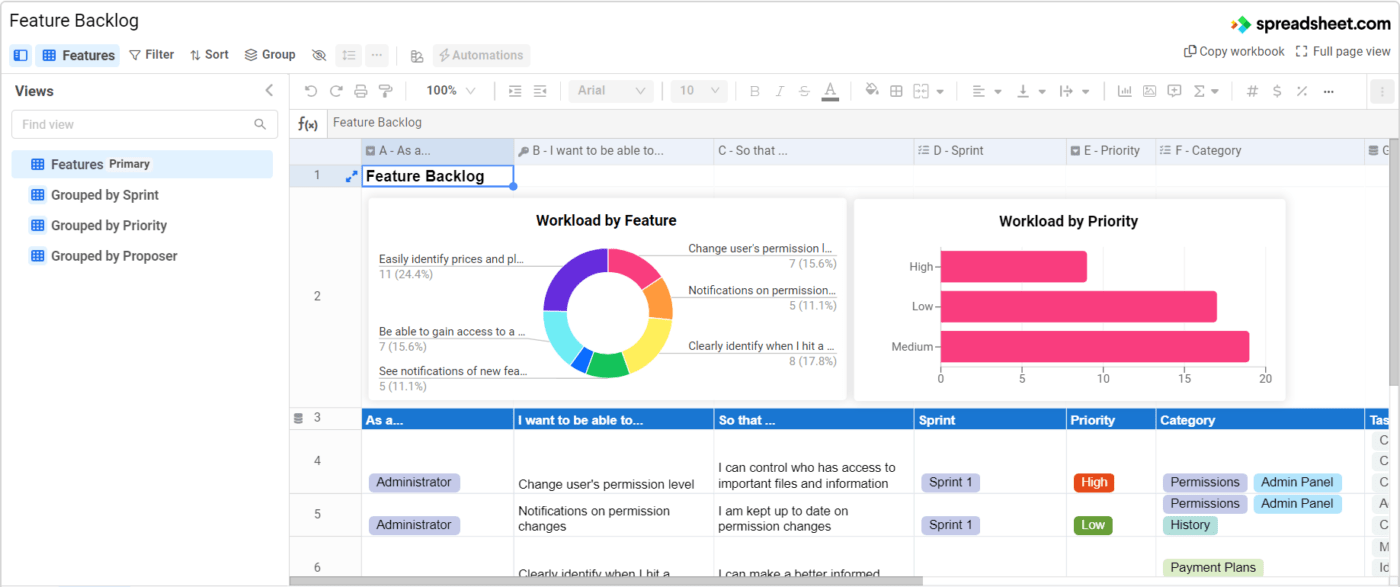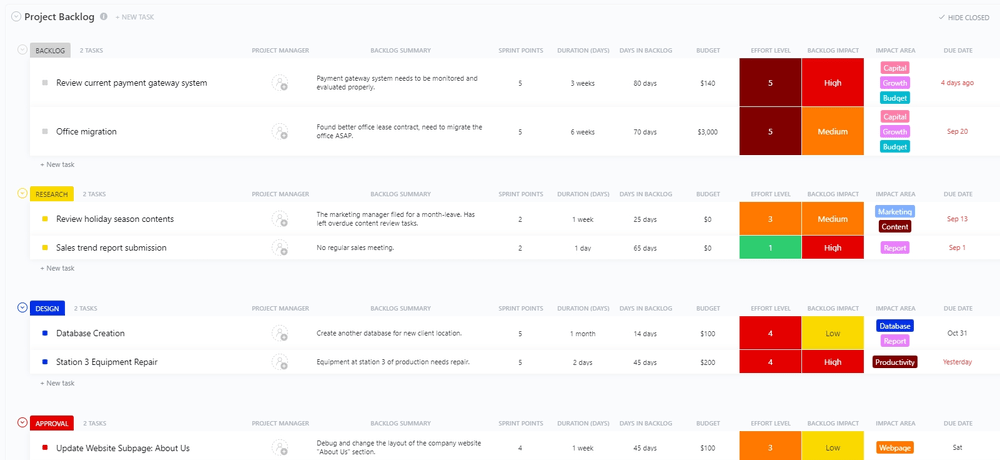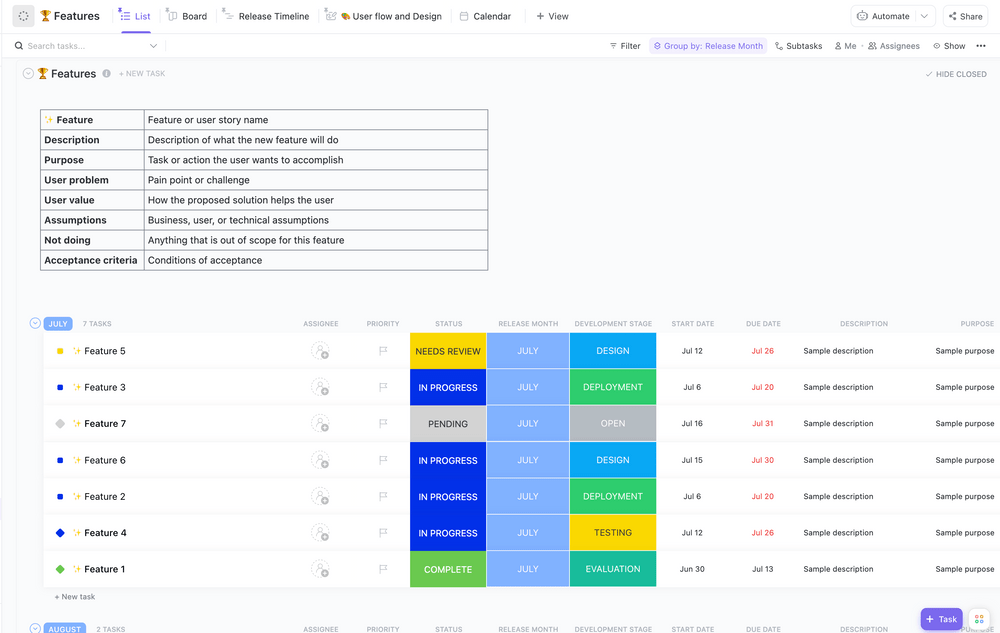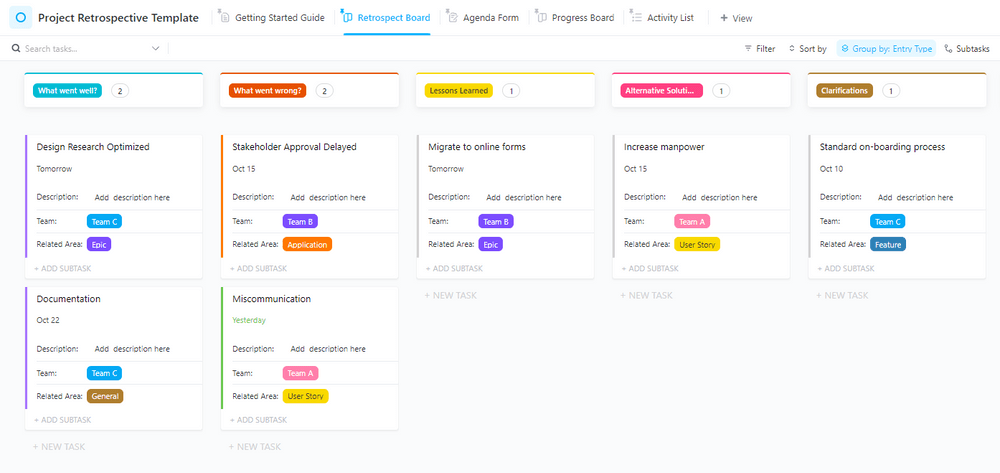The wisest Agile players often lead with a simple statement, “Trust me, it’s on the backlog.” Is it, though? ?
You can create the most ambitious product development roadmaps with high-end themes and conceptualizations, but they are impractical without backlogs.
Backlogs are documents carrying a heavy load for teams planning their next development cycle. We’re talking critical reports with info on bug fixes, feature and design changes, customer requests, and user stories.
They help your team prioritize tasks for future sprints and find ways to meet stakeholder requirements. Without addressing backlogs, your project is practically derailed. ?
For backlog grooming to be productive, your documentation game has to be on point—that’s where product backlog templates come in. This article brings you the 10 best templates for building value-driven product backlogs and improving team velocity! ?
- ⏰ 60 Second Summary
- What Is a Product Backlog Template?
- What Makes a Good Sprint Product Backlog Template?
- 10 Free Product Backlog Templates to Use
- 1. ClickUp Product Backlog Template
- 2. ClickUp Product Backlog & Sprints Template
- 3. ClickUp Product Sprint Backlog Template
- 4. ClickUp Project Backlog Template
- 5. ClickUp Agile Sprint Planning Template
- 6. ClickUp Product Requirements Template
- 7. ClickUp Product Launch Checklist
- 8. ClickUp Sprint Retrospective Template
- 9. ClickUp Project Retrospective Template
- 10. Excel Features Backlog Template by Spreadsheet.com
⏰ 60 Second Summary
Here are 10 free product backlog templates to keep your team organized, focused, and ready for the next sprint:
- ClickUp Product Backlog Template
- ClickUp Product Backlog & Sprints Template
- ClickUp Product Sprint Backlog Template
- ClickUp Project Backlog Template
- ClickUp Agile Sprint Planning Template
- ClickUp Product Requirements Template
- ClickUp Product Launch Checklist
- ClickUp Sprint Retrospective Template
- ClickUp Project Retrospective Template
- Excel Features Backlog Template by Spreadsheet.com
What Is a Product Backlog Template?
A product backlog template is a collaborative document for anchoring a backlog grooming session. It helps a product owner and/or manager summarize past development cycles in an Agile framework and define the goals that must be completed in the next sprint. ?
The main purpose of these project management templates is to reduce unstructured, ever-evolving backlog items into manageable to-do lists and actionable tasks. Instead of wasting time on what to work on in an upcoming sprint, your teammates get a precise set of rules, roles, and responsibilities to develop the product according to priority needs.
Product backlog templates take many shapes and forms, depending on the type of backlog you’re handling. In most cases, the document addresses one or more of the following backlog components:
- Epics, features, and user stories
- Change requests
- Defects and bugs
- Technical debt (the cost of implementing mediocre code in the short run)
- Tech spikes or research items
- Business requirements
What Makes a Good Sprint Product Backlog Template?
An effective product backlog template should:
- Be customizable: The template should adapt to different products, development niches, and industries. Ideally, a good sprint backlog template is supposed to be a “living document”, providing room for sudden and unexpected changes as the product evolves ♻️
- Have a clean structure: It should contain straightforward sections and headings to deliver specific backlog items to the intended team without clutter
- Offer collaborative features: The best backlog templates help define the expectations of each team member and promote collaborative work toward common goals
- Allow prioritization: It should allow you to highlight the importance of backlogs based on the complexity, size, or effort required
- Include visuals: It should support adding charts, graphs, diagrams, story points, and other visuals that add context and support tasks ?

10 Free Product Backlog Templates to Use
There are thousands of product backlog templates on the internet, but finding the one that aligns with your needs is tricky. To save you time, we’ve hand-picked 10 impressive options from ClickUp and Excel that can accommodate different backlog exercises! ❤️?
1. ClickUp Product Backlog Template
Looking for a versatile document to streamline your Sprints, prioritize product requirements, and foster team collaboration? Fall back on the ClickUp Backlog Template! ?
This beginner-friendly template is a must-have for remote or distributed software development teams. Anyone with access to it can issue change requests, bug reports, research suggestions, user stories, features, and more!
The template comes with a Ticket Submission Form you must share with participating internal team members or stakeholders. The magic starts once they fill out the form with priority backlog items. ?
The items automatically appear in the template’s views, allowing you to kickstart Sprint planning and set up actionable tasks. You have six view types for reflecting different perspectives, including:
- Product Backlog View: for displaying deadlines, priorities, assignees, and epic categories
- Schedule (Gantt chart) View: for focusing on scheduled dates, product roadmaps, and durations
- Sprint (List) View: for displaying items according to the Sprint they belong to
- Backlog Status View: for turning submitted items into Kanban board cards
Use the template’s Custom Fields to sort the backlog into Sprints or Epics and break them into smaller tasks. Change the status of tasks to Done, Canceled, In Progress, or On Hold to keep your team in the loop. ➿
2. ClickUp Product Backlog & Sprints Template
Agile project development is incredibly fast-paced, which can leave Scrum masters feeling whiplashed every time they’re hit with backlogs. ?
The ClickUp Backlog & Sprints Template is geared toward Agile managers and Scrum masters aiming to deliver the best within brutal deadlines. Its three-tiered format allows you to set clear and consistent priorities, develop cohesive backlogs, and extend updates to teammates and developers in a single document.
With this agile product backlog template, you can:
- Access pre-built Lists for Sprints, bug tracking, and backlogs
- Prioritize backlog items
- Assign tasks to multiple team members
- Post daily stand-ups
- Track the progress of assigned tasks with a product roadmap
- Identify problems in real time
- Use other pre-built project management templates within ClickUp
Don’t be overwhelmed by the template’s widespread coverage—managing your backlog’s content is effortless thanks to multiple view types and 20+ status options.
The template’s four project views—List, Form, Board, and Chat—have pre-built Custom Fields for following up on how the tasks are shaping up. You can add details like story points or feature info to assist developers.
Further customize your backlog by adding task dependency warnings, time estimates, work-in-progress limits, and milestones. This template doubles as a product management document, capturing every aspect from development to launch! ?
3. ClickUp Product Sprint Backlog Template
Had your daily Scrum meeting and realized some backlog tasks require heavy updates? It can be a scary deer-in-the-headlights situation if you don’t know how to proceed. ?
No stress, though! With the ClickUp Sprint Backlog Template, you have absolute control over your backlog vehicle regardless of its twists and turns! ?
This template is designed to keep you focused on the big-picture in the face of moving targets. Sprint backlogs are typically detailed and tied to a specific timeline—even the smallest modifications can wreak havoc on your schedule. But with this agile product backlog template, you get to track the development status of items on a daily basis. ?
Worried about staff and resource allocation as new information comes up? Nothing to worry about here—the template’s Custom Field for Effort helps you run a team with enough flexibility to accommodate new to-do items.
Navigating the template is fairly easy, even for rookie leaders. Open it, and you get the Backlog (List) View by default, which is ideal for creating tasks and subtasks, setting due dates, checking progress, and tracking time. The backlogs are generally classified into four categories:
- User Story
- Task
- Bug
- Improvement
You can add more categories or switch to different view types as you please!
4. ClickUp Project Backlog Template
If your backlog exercise contains advanced long-term goals like researching holiday sales potential and creating databases, add the ClickUp Project Backlog Template to your toolkit! ?
This template helps you handle backlogs from a time investment and cost perspective. It can adapt to any large-scale strategizing activity throughout a project’s lifecycle. Whether reviewing sales trends or improving payment gateways, use the template to chop expansive targets into smaller, digestible tasks.
At its core, this template is about estimating durations, prioritizing tasks, and refining items included in the backlog. You get six view types to micromanage completion timelines and monitor individual days in the backlog, used budget, and due dates for each task. ⏳
The template lets you sort backlogs into five groups:
- Backlog (for general backlogs)
- Approval
- Design
- Research
- Execution
The categorization makes it easy for cross-functional teams to locate items that concern them right away. You can also add crisp backlog summaries to provide a rich context to the teammate(s) addressing the task.
5. ClickUp Agile Sprint Planning Template
Mastermind planning increases the success rate of Agile Sprints and adds value to every task done to date. Fail to do that, and you’re letting a ship run loose—your entire team won’t know what to prioritize, and their efficiency will plummet. ↘️
Trust the ClickUp Agile Sprint Planning Template to keep that ship afloat and the sailors in sync. ⚓
The template helps you set realistic expectations based on current capacities. That way, you can establish accountability whenever there’s a discrepancy between actual and estimated hours.
To stay on top of tasks, you get three views—Sprint Backlog Items, Development Status, and Resources.
The Sprint Backlog Items View provides an overview of tasks classified by types like User Story, Bug, and Feature types. Add or remove assignees, set due dates, and provide time estimates.
The Development Status View displays your tasks according to their development status and priority in a Kanban-style setup. Since the template allows dragging and dropping, moving the task cards around is seamless.
The Resources View works like a calendar to plan and review your team’s workload. Observe differences between the estimated and actual task times instantly and share the data with your staff during retrospective meetings. This will help your team to work collectively on plans to improve efficiency.
6. ClickUp Product Requirements Template
If your next backlog grooming session is heavily about tailoring your product to stakeholder needs, it’s best to use ClickUp’s Product Requirements Template. ?
Instead of an elaborate document with generalized sections, you get a beginner-friendly template summarizing everything about a product—including features, functions, and values. It’s a major time-saver because it presents a history of prior tweaks and requested changes in a single window. ⏲️
Dealing with multiple product launches? Create folders for each product and enjoy plenty of space to discuss current and planned features, their values, and market assumptions. You can also add tasks for every feature/user story, set deadlines, and track development through stages.
Depending on the type of product you’re working on, you get 17 different status updates for tasks. Besides offering sharp visibility, the template includes time tracking to speed up change requests before the release date.
The template forges a collaborative environment by enabling internal and external stakeholders to record their contributions. As for task assignees, you can add details and instructions to guide them and minimize the risk of misunderstandings or miscommunication. ?
7. ClickUp Product Launch Checklist
Three, two, one, go! The product launch (or relaunch) is likely the most thrilling part of product management, assuming it’s executed well. A successful launch expands your customer base and revenue, but an unsuccessful one might as well be a death sentence for your product. ⚰️
The ClickUp Product Launch Checklist prevents worst-case scenarios, helping your launch become an epic success. It’s packed with convenient features to deal with unaddressed backlogs and potential risk factors well ahead of the launch date.
The template’s Activities View is where you create an overview of every launch-related activity. Customize tasks with assignees, comments, start and due dates, and priority statuses. ⛳
Other views include Milestones, By Category, and Timeline, perfect for sorting backlogs based on the development stage or getting a more visual estimate of in-progress tasks.
This advanced-level template is designed to micromanage everything before a product launch, from task sequences to dependencies. We recommend it whenever you have a lot on your plate and need a centralized template to steer the launch in the right direction. ☸️
8. ClickUp Sprint Retrospective Template
Every Sprint retrospective ends with an updated list of backlogs. Addressing them early on is the best way to add value to each meeting and bulk up team productivity. ?️
If your team is struggling to keep up with product backlogs from frequent retrospective sessions, the ClickUp Sprint Retrospective Template can save the day. The template helps you turn loose Sprint outcomes into action lists—but with the added convenience of brainstorming support, thanks to ClickUp Whiteboards.
With this Whiteboard-based template, you have a customizable playground to get your team onboard for real-time collaboration. Discuss how to manage the latest backlogs and reevaluate your stand on the pending ones from older retrospectives.
Participants can add their perspectives to four sections:
- What went well
- What could be better
- Action items
- Retrospective goals
Priority backlog tasks can go under Action items, while non-priority activities can be parked under What could be better.
9. ClickUp Project Retrospective Template
Every finished project, whether a success or a failure, is a valuable lesson—and a gold mine for digging out crucial backlogs. ?
Have the ClickUp Project Retrospective Template by your side when you revisit completed projects and reflect on what went right or wrong. ?
The best way to extract backlogs with this template is by accessing the Agenda Form. Forward it to your project team members and see what entries come up. The information can be displayed in five different views—use the Retrospect Board View to get a gist of core backlog areas like:
- What went well?
- What went wrong?
- Lessons learned
- Alternative solutions
- Clarifications
The template lets you create tasks, add supporting documents, and put members in charge of activities that could lead to the refined execution of future projects.
10. Excel Features Backlog Template by Spreadsheet.com

Working on a new product can give you sleepless nights if you have mental blocks about feature requirements and expected workloads. Power up your product strategies with the Excel Features Backlog Template by Spreadsheet.com.
The standout feature of this product backlog template is that it’s Excel-based, making it ideal for those who prefer spreadsheets and tables.
The product backlog tool comes with preset rows to track the development of new features. Add rows to define product and user categories, priorities, criteria for successful updates, and team capacities.
The template is easy to use—helping you monitor new feature additions and determine how they impact the development process. Create tasks, set priorities and deadlines, and leave notes to address backlogs meticulously.
You can also group backlogs according to features if you want to tackle them in bulk. Besides tables with data, this template relies on bars, graphs, and charts to make information easier to grasp for visual learners.
Boss Your Backlog—Or Let It Boss You?
Teams using an agile methodology often find themselves stuck in a vicious cycle of being pushed around by backlogs and losing time, to the extent that it invades everyone’s peace of mind. The only way to prevent this is to keep your backlog counter light and well-managed. ?️
The templates we provided will help you build a strong backlog culture, ultimately supporting the launch of well-rounded, tested products that meet stakeholder requirements! ✌️












